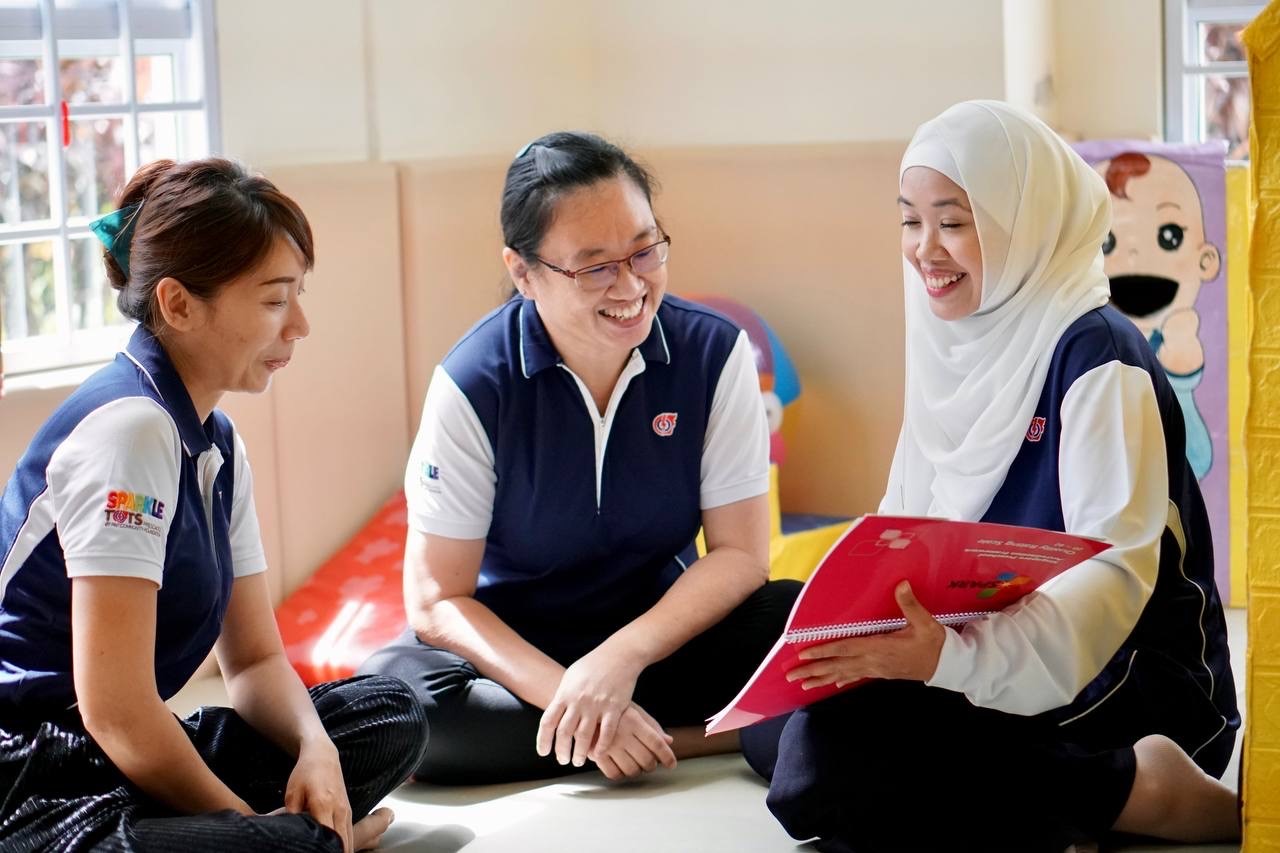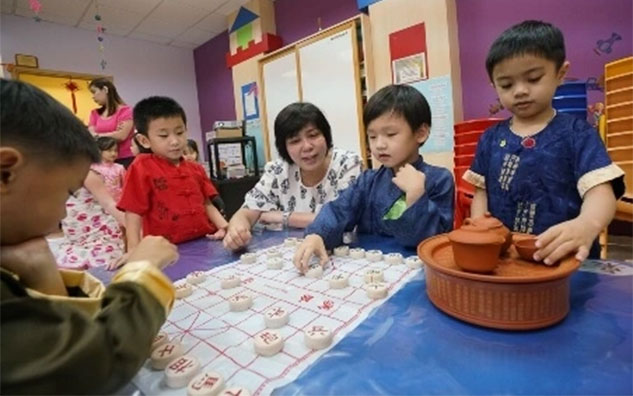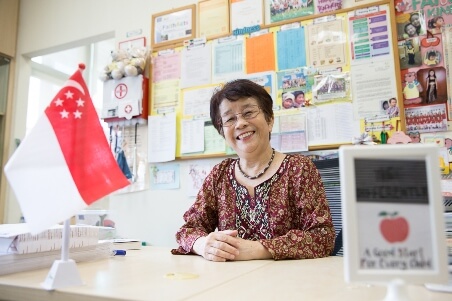Connecting the Dots - From Survival to Maturity

Through the Inquiry-Based Action Plan (IBAP) projects, ECDA Fellows Rebecca Han and Shirley Tan share with centre leaders how to connect the dots and implement their centres’ vision, mission and core values through a more holistic approach.

Rebecca (left) and Shirley (right)
It is never easy for a new early childhood educator to transit into the sector and new working environment. Many preschools conduct induction programmes to help new educators familiarise and internalise the organisation’s policies and processes as well as vision, mission and core values (VMC).
ECDA Fellows, Ms Rebecca Han and Ms Shirley Tan, found out that despite all the efforts put into developing and implementing induction programmes, many centre leaders still have difficulty motivating their new educators to work towards the organisational goals and objectives.
Believing in a more holistic approach, both ECDA Fellows felt that it would be essential for centre leaders to integrate their VMCs into their daily centre practices and processes. This led them to develop the IBAP project “Connecting the Dots – From Survival to Maturity”.
SIMON SINEK’S GOLDEN CIRCLE MODEL
“Connecting the Dots – From Survival to Maturity” is anchored on Simon Sinek’s Golden Circle Model. Backed by neuroscience research, Sinek’s model aims to guide leaders and organisations to inspire and motivate employees rather than manipulate or demand action. Sinek’s Golden Circle Model comprises 3 key components – ‘What’, ‘How’ and ‘Why’.

- What – Refers to the services, products or functions that are done or produced by the organisation
- How – Refers to the value proposition of an organisation or unique things that make an organisation special or differentiate them from their competition.
- Why – Refers to an organisation’s purpose, cause or beliefs. This is usually not profit-driven but inspirational and influential to employees. An organisation’s VMCs are usually deeply rooted in the ‘why’.
According to Sinek, many leaders and organisations start thinking about ‘What’ they want to achieve before figuring out ‘How’ to achieve it. They also tend to neglect the ‘Why’ and fail to examine the emotional core of what makes employees and customers buy into a company. It is important for leaders to help employees connect the dots between the ‘What’, ‘How’ and ‘Why’ to motivate and inspire them to do their best in their work.
Says Sinek, “If you hire people just because they can do a job, they’ll work for your money. But if you hire people who believe what you believe, they’ll work for you with blood and sweat and tears.”
CONNECTING THE DOTS THROUGH IBAP

In their IBAP project, Rebecca and Shirley use the Golden Circle Model to help centre leaders identify possible ways of guiding staff in connecting the dots between ‘What’, ‘How’ and ‘Why’. Through adopting the Golden Circle Model, centre leaders can work towards better centre management, more focused centre programmes, more coherent centre processes and stronger staff support.
Ms Tham Kum Fong, Principal of Singapore Hokkien Huay Kuan Pre-school, and Ms Serena Cheok, Principal of Shalom Kindergarten, came on board the IBAP project to create action plans to improve staff motivation and strengthen their centres’ VMCs.
Recalling her experience from the IBAP workshops, Kum Fong shared, “Both (Rebecca and Shirley) guided us to link up every aspect (or little ‘dot’) in our course of duties. The ‘dots’ are kneaded closely and should not be isolated. Every change will affect all the little dots. When put in the right places, the whole system will move smoothly in the same direction.”
As part of the IBAP experience, the centre leaders then implemented what they had learnt in their respective centres. Both Shalom Kindergarten and Singapore Hokkien Huay Kuan Pre-school re-examined their existing VMCs and figured out strategies to integrate the VMCs into their centre processes and help their staff internalise them.
“We realised that some of our original core values were actually desired outcomes that we hoped to achieve. We also realised that not all our values would be embraced by our team, children and parents. We got the team to write down the values they would be committed to embrace. We then discussed ‘how’ to fulfil our mission and realise our shared vision.” Serena shared.

Kum Fong added, “I started with ‘WHY’ and traced back the history and main objectives of setting up our school. We then linked the objectives to our centre’s VMCs. I make it a point to include our VMCs in regular staff meetings. I also try to get our teachers to align with the preschool’s VMCs during our discussions or feedback sessions.”

However, restructuring and relooking at a centre’s VMC can be a challenging process. Kum Fong pointed out that it certainly wasn’t a bed of roses: “It takes (the team) time to follow, adjust and align. From acceptance to believing in it and finally changing their mindset. It is a long process. Patience is key. And, I must be able to catch the right learning moments to reinforce their understanding or praise them.”
The IBAP workshops by Shirley and Rebecca have proved to be effective in guiding centre leaders towards this objective. As Serena highlighted, “The topics covered in the IBAP are very relevant and practical. Centre leaders gain more knowledge and skills in leadership practice. Through IBAP, the centre leaders learn how to better guide staff to be more intentional in including core values in lesson planning and teaching, in assessment of children’s learning, and in reflection on how to improve their practices to support children’s learning.”
Serena’s views were seconded by Kum Fong: “All these are tried and tested management and planning skills and wisdom. I found every session enlightening. We have also formed our network to support each other in managing our centres. And our facilitators (Shirley and Rebecca) have also become my consultants.”
Learn more about the IBAP project “Connecting the Dots – From Survival to Maturity” from Ms Shirley Tan!
Curious about who the ECDA Fellows are? Find out more about the ECDA Fellows initiative here!
Read about the Inquiry-Based Action Plan (IBAP) projects conducted by the ECDA Fellows here!
You may also like

From Cabin to Classroom: Journey of an Outstanding Early Childhood Educator
The PDP modules allowed me to get creative with lesson ideas and keep up with the ever-changing Early Childhood sector.

Ms Farhana Binte Mohamed Hassan
Early Years Educator - PCF Sparkletots @ Pioneer Block 987D (CC)

Translating Passion to Profession: Angelene, Nurziana and Sharidah's Voyage in Early Childhood Education
PDP has undoubtedly deepened the skill sets and enriched the expertise of exemplary educators such as (Nur)Ziana and Sharidah

Ms Jegatheswary
Cluster Head at Sunflower Preschool

An Unwavering Passion
You need to have a passion for children, and I don’t mean just teaching them, but caring for them as well

Mrs Elsie Yee
Principal - Faith Kindergarten